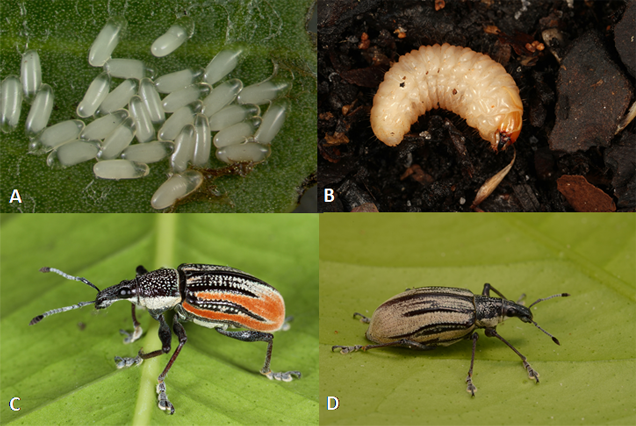Russ Mizell and Xavior Martini, UF/IFAS Entomologists, NFREC, Quincy
Citrus production in North Florida is expanding rapidly in response to the devastation of citrus in Central and South Florida due to citrus greening disease. Citrus acreage in southern Georgia is also increasing. Florida’s climate is situated in the temperate (North) and subtropical (Central and South Florida) regions. Thus, non-native pests from other similar habitats around the world can and frequently do become established in Florida. For example, some non-native pests of citrus that are well established in subtropical Florida include Diaprepes abbreviatus, better known as the “Apopka weevil,” the sugarcane rootstook borer, and the Sri Lanka weevil, Myllocerus undatus. Both of these weevils feed on citrus leaves as adults and their immature stages feed on the roots. Both species also feed on a wide range of other plant species damaging leaves and roots.
The annual low temperatures observed in North Florida the last few years have been higher, possibly due to climate change, and as a result have enabled some pests usually restricted to the subtropical areas of Florida to expand their ranges into the North Florida temperate zone. In addition, expansion of citrus culture with the corollary acceleration of plant movements across the state increase the risk of pest introduction from southern parts of Florida.
Via this article, we are alerting extension personnel, home gardeners, and more specifically citrus growers and nurserymen that the Apoka weevil, Diaprepes abbreviatus has been detected for the first time in an established population in Jefferson County, FL. The Apopka weevil was found in a nursery in Jefferson County, and has not been found in citrus in North Florida to date. The Apopka weevil has several hundred known host plants including citrus, sugarcane, vegetables, fruits and many woody landscape plants. Sicklepod, Senna obtusifolia, and pokeweed, Phytolacca americana, appear to be favorite adult hosts in North Florida in August-September. The large black and white-striped and often orange colored adults (Fig. 1 – C and 1D) feed on fresh leaves where they place their white egg masses in pouches (Fig. 1 – A) made from 2 leaves connected together. The larvae (Fig. 1- B) hatch and fall to the ground where they feed on plant roots often at depths of 1-2 feet or more. There are 2 generations per year in southern Florida, but the number and timing of those that will occur in north Florida remains unknown. Adult weevils are easily detected, and often occur as mating pairs. They are not known to be great fliers; however, the larvae can be found in, and be spread around while infesting plant roots in containers.

Fig. 1: Diaprepes abbreviatus (A) eggs (B) larva, (C) orange form adult, and (D) white form adult. Picture by Tai Huang (A) and Lyle Buss (B, C and D).
This weevil is a quarantined pest, so nurseries in infested counties are required to follow specific insecticide treatments prior to shipping outside of the quarantine area. Producers of any potentially infested crops should monitor visually for the adult weevils by looking for feeding damage and adult weevils on the crop and associated weeds.
Further information on this insect pest can be found in the following UF/IFAS publication: Diaprepes Root Weevil, Diaprepes abbreviatus.
- Apopka WeevilConfirmed in Jefferson County Nursery - September 14, 2018
- Potential Pests and Diseases of Olives in Florida - October 14, 2016
- Plant Recommendations to Augment Ecosystems Services - February 12, 2016
